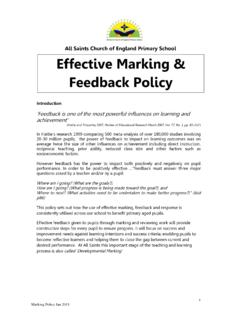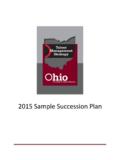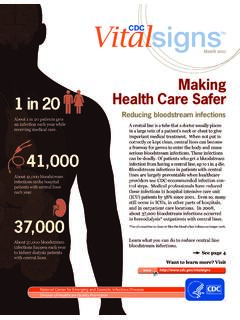Transcription of A Parents’ guide to…. How we assess other primaries.
1 A Parents guide How we assess progress & ATTAINMENT WHAT IS NEW? WHAT ARE THE CHANGES? A BRIEF SUMMARY (FOR FURTHER INFORMATION PLEASE READ THE WHOLE LEAFLET) A L L S A I N T S C O F E P R I M A R Y S C H O O L All growing, all learning, altogether. From September 2014 how schools assess children s progress and attainment is changing. The New Curriculum requires that schools no longer use the Level system Read here to find out how All Saints assess and track pupil s learning to en-sure your child makes good progress throughout their time with us. The National Curriculum has changed . It has more con-tent , and is pitched higher. It now gives Age Related Expectations for each year group. The Government want all schools to develop their own tracking methods to record attainment and progress using the new Age Related Expectations. The old levels will no longer be used. Bands will re-place levels to reference attainment.
2 The bands relate to each year group. Here are the new bands we will be working with. Each band is roughly 3 terms of learning. This is further denot-ed steps: B/W/S if a child is Beginning that band, is Work-ing within or Secure, ready to move on to the next band. A + will indicate when a child is well within that that step A new attainment level will be written (eg) 2W+ Not all children will start at B for the beginning of the year, it will depend on individual children and their needs. Each child still have their own starting point as they pro-gress through the school. The new B does not link to the old 1B/2B/3B etc etc. All growing, all learning, altogether. All growing, all learning, altogether. Frequently Asked Questions Why is the system changing? It is part of the new revised National Curriculum. The Government wants a simpler system for parents to understand and for each school to develop their own. Will children still have SATs?
3 Yes, SATs this year will be the same as previous years. This year the Year 2 curriculum stays the same because children will be assessed on this. So Year 2 children are also being tracked in the old level this year. Next Year the SATs will alter. This is the same for Yr 6 pupils at High School and in other primaries. What can I do to help my child? There is so much parents can help with, reading is very important along with time tables, spellings and practicing number bonds. Also completing home-work as well talking about what they are learning at school. Our website has links to supporting website and the BBC website where there are lots of fun games to support primary learning. Your class teacher will also give you some specific pointers to help your child at home. What do teachers use to gauge children s progress ?Children s independent work is the biggest indicator of what they can do and how they do it. Teachers use this on a daily basis to know and check pupil understanding and progress .
4 Special pieces of work to inform assessment is set up throughout the year. This is done along side Reading and Spelling age tests, the Phonic screen in Yr 1, Year end tests in KS2 and the EYFS Profile . How is the progress between each step worked out? At All saints we use the Symphony Assessment System to bench-mark progress . This has been developed by Leicestershire schools and is used nationally. How do all schools know that their judgements about progress and attainment match up with each other ? At All Saints we work across the school and with other local schools to agree and moderate attainment levels. All school also have external moderation from the Local Authority. What happens when my child goes to high School? High schools too will have their own systems and will work with the primaries to ensure that the systems work together, so there is continuity for children s progress . Yr Autumn Spring End of year/ summer 1 1B 1W 1S 2 2B 2W 2S 3 3B 3W 3S 4 4B 4W 4S 5 5B 5W 5S What is new?
5 Children in the EYFS continue to be tracked on the Devel-opment Matters bands of the Early years Foundation Stage Curriculum. By the end of their Foundation Year in school it is expected that they reach the Early Learning Goals . At the beginning of the year a baseline assessment is made of everything they can do so teachers know what they need to learn next. This is shared at the first parents evening of the year. Children are tracked through their reading, writing and maths development by what they write down, through careful observation of what they can do, how they interact with others and how they explain what they know. A learning Journey is kept of their development which we will share with you through out the year, parents can contribute to this to include what children can do and are interested in at home. At the end of the EYFS year the EYFS Profile completes the picture of every-thing they have learnt, and are able to do.
6 This is reported to parents in July, so parents know if their child is at the age related expectation, is emerging into this or exceeding above. Most importantly it shows how much progress has been made from the baseline, and so teachers in Year 1 are ready to teach them their next steps in the National Curriculum. What is Staying the same? progress within bands: As children develop through each Band, we track their progress very carefully. Each Band is broken into 3 steps which roughly represents a term s progress . Over the year the steps are called: beginning, (B) within (W) and secure (S)* The changes are for children in Years 1-5, they are taught the National Curriculum. The National Cur-riculum has changed and with it the way all schools track attainment and progress . Previously, if you have a had child in school, teachers will have given you a Level to represent your child s attainment . For example 3C The number gave the level and the letter denoted steps within that level.
7 So 3C would be a child just entering Level 3, and 3A a child who was secure in the level and ready to move on to level 4. Because of the way old curriculum worked the numbers did not automatically represent the year group a child would be in. The new National Curriculum has been written to give Age related expectations (ARE) for the end of each year. As chil-dren travel from Year 1 to Year 5 in our school, they will be tracked against the Age Related Expectations. At All Saints these are numbered bands. The bands give the level of attainment So Year 1 is band 1, and so on until Year 5 is band 5 and Year 6 is band 6. Because all children are individual and develop at different rates and have differing needs, they will work in the band which is appropriate to them to make sure that learning makes sense. Extra help or challenge is given to make sure they are learning at the right level. Teachers can further break down each step into two in order to tightly track children s progress and ensure they are con-stantly moving forwards and building on their previous learn-ing.
8 The extra steps are denoted with a + 2W+ shows a child is working well within Band 2 This gives a total of 6 steps for a year. Where ever children begin their learning in September we expect them to make 6 steps progress So if they start at 2W+ in Year 3, we generally will expect them to be at least 3W+ at the end of Year 3. Over time accelerated progress of more than 6 steps will close gaps. Year Autumn Spring Summer 1 1 B 1 W 1 S 2 2 B 2 W 2 S 3 3 B 3 W 3 S 4 4 B 4 W 4 S 5 5 B 5 W 5 S Not all children will start on B in the Autumn term, Not to be confused with the old 1b /2B/3B/4B etc This is a transitional year, when children will be moving from the old to the New National Curriculum. The New Curriculum is pitched higher and has more content. Not all children will start at B for their band, but we have high expectations of our children to meet this challenge as they pro-gress onto the new curriculum. We also expect that this will be demon-strated in the steps progress they make this year as new curriculum con-tent is consolidated and becomes embedded.
9 CHALLENGE 2014-15 * All Saints uses Target Tracker to track data. This is a tool that thousands of schools use. Nationally. The B/W/S system is devised and supported by Target Tracker.







